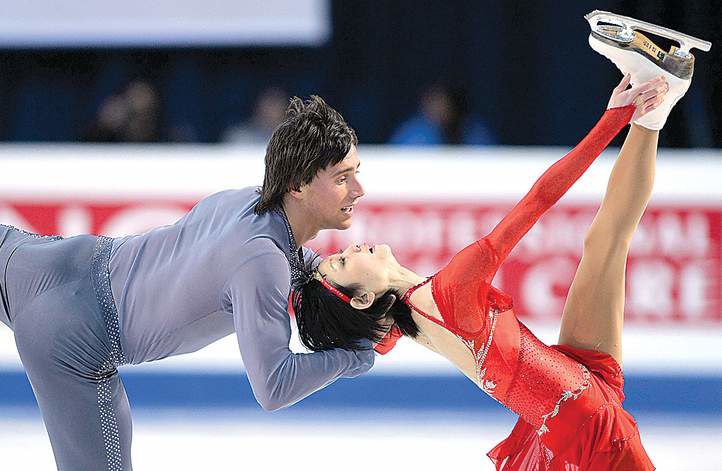Switching nations to find the right mix of skating partners
Published 4:00 am Thursday, January 28, 2010

- Russia's Yuko Kavaguti, right, and Alexander Smirnov, left, perform their free program at the ISU European figure skating championships in Tallinn, Estonia, this month.
TALLINN, Estonia — She is a 20-year-old from Richmond, Va. He is 24 and from Whitby, Ontario. Together, they compete for Greece as a professional pairs figure skating team.
The globalization of skating, as exemplified by Jessica Crenshaw and her skating partner, Chad Tsagris, was on full display at the European championships here last week.
While countries of origin and nationality were once determining factors, rules changes and increased movement of talent across borders make for ever more exotic mixes on and off the medal stand. Of the 16 pairs who made it to last week’s free program, six were composed of skaters who started their careers competing for different countries. Of the 26 teams in original dance, nine were in the same situation.
There were Frenchmen skating for Italy; Ukrainians skating for Bulgaria and Germany; and a Canadian-born Briton skating for France.
There was also Yuko Kavaguti, a former singles skater from Japan whose surname was Kawaguchi before it was modified after she took Russian nationality and her name was transliterated from official Russian documents.
“Just about anything is possible,” said Rocky Marvel, a former U.S. pairs champion who is now based in Mt. Laurel, N.J., and coaches Crenshaw and Tsagris.
International Skating Union rules require only one member of a pairs or ice dance team to have a passport from the country they represent. In order to increase the competitive pool and allow skaters to find partners more easily in disciplines that were losing numbers and relevance, citizenship rules were eased in 2006. Skaters who switch allegiances after representing another country must now sit out just one calendar year, instead of two, before representing their new nation in ISU championships. The one-year rule applies only if their former nation releases them.
“They had to do it to save the sport,” said the British pairs skater David King, who has not teamed with a foreigner but skates with his compatriot Stacey Kemp. “Look, not many teams were coming. There were only 11 or 12 in Europeans a few years ago. So they had to mix it up a bit. This year we had 21 teams in Europeans, so it’s fantastic. It’s pushing the sport. It’s so easy to travel these days. It makes no sense to have teams from just one country.”
In other sports, like tennis, doubles players who play on the regular tour with a partner from another nation can easily find a partner from their own country for the Olympics. But pairs and ice dance teams generally require years of training together to reach the elite level. Kavaguti left Japan in 1999 to train with the renowned Russian pairs coach Tamara Moskvina in New Jersey. She represented the United States for a period with an American partner before moving to Russia with Moskvina in 2003. She ultimately renounced her Japanese citizenship so she could compete with Aleksandr Smirnov at the highest level, including the Olympics.
“It’s strange to need a visa to go back to your own country,” said Kavaguti, the first international-level skater from another country to represent Russia.
But after her decade-long quest, the delicately built yet strong-willed Kavaguti received her first major reward last week. She and Smirnov upset Aliona Savchenko and Robin Szolkowy of Germany, who had won the last three European titles and the last two world titles.
Many of the skaters who have switched nations could not find partners in their own countries.
“For pair girls, there are 100 girls for every one guy who wants a partner,” Crenshaw said. “To be able to find a partner and to be able to compete in Europeans and go to worlds, it’s actually almost a miracle.”
Crenshaw’s near-miracle was made possible by the fact that Tsagris’ father is Greek.
Caitlin Mallory, a 22-year-old studying neuroscience at the University of Michigan, could not find an American partner, so she is competing for Estonia with Kristjan Rand.
“It’s wonderful to have the support of a country behind you,” Mallory said, “but day in and day out, you are training just the two of you together.”
Mallory and Rand, who finished 13th here, were good enough to qualify last year for the Olympics. But because of Estonia’s laws against dual citizenship, Mallory would have had to renounce her United States citizenship to be eligible.
Mallory said she was unaware of Estonia’s citizenship restrictions when she and Rand joined forces, but she said she had not explored it, in part, because she never expected they would become an Olympic-caliber team so quickly. Mallory said she was initially prepared to abandon her U.S. citizenship, even though this was only her fourth visit to Estonia and she does not yet speak the language fluently. But she said she changed her mind after the documents arrived last year in the United States, where she and Rand have their training base.
“It was a hard, really hard decision,” she said. “When it came down to the last month before I really had to make the decision, I consulted my parents and some lawyers to try to work out what it would mean logistically for me to be able to go to school in Michigan and be able to continue training in the U.S., and we just realized it was too much of a sacrifice for one competition.”
The consolation prize was having the pleasure of performing in these championships for a home crowd in Estonia. It was hardly the home crowd she would have imagined growing up in Berkeley, Calif., but then modern figure skating is full of such surprises.
The host announcer had just finished his interview with the new European pairs champions, and the two Russian skaters each thanked the crowd.
“Spasiba,” Smirnov said.
“Arigato,” Kavaguti said.






